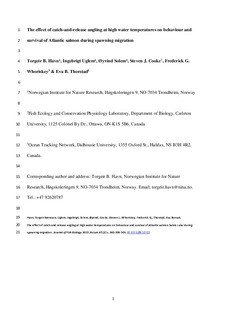| dc.contributor.author | Havn, Torgeir Børresen | |
| dc.contributor.author | Uglem, Ingebrigt | |
| dc.contributor.author | Solem, Øyvind | |
| dc.contributor.author | Cooke, Steven J. | |
| dc.contributor.author | Whoriskey, Frederick G. | |
| dc.contributor.author | Thorstad, Eva Bonsak | |
| dc.date.accessioned | 2018-01-30T10:50:45Z | |
| dc.date.available | 2018-01-30T10:50:45Z | |
| dc.date.created | 2015-08-25T10:31:53Z | |
| dc.date.issued | 2015 | |
| dc.identifier.citation | Journal of Fish Biology. 2015, 87 (2), 342-359. | nb_NO |
| dc.identifier.issn | 0022-1112 | |
| dc.identifier.uri | http://hdl.handle.net/11250/2480608 | |
| dc.description.abstract | In this study, behaviour and survival following catch-and-release (C&R) angling was investigated in wild Atlantic salmon Salmo salar (n = 75) angled on sport fishing gear in the River Otra in southern Norway at water temperatures of 16⋅3–21⋅1∘ C. Salmo salar were tagged externally with radio transmitters and immediately released back into the river to simulate a realistic C&R situation. The majority of S. salar (91%) survived C&R. Most S. salar that were present in the River Otra during the spawning period 3–4 months later were located at known spawning grounds. Downstream movements (median furthest position: 0⋅5 km, range: 0⋅1–11⋅0 km) during the first 4 days after release were recorded for 72% of S. salar, presumably stress-induced fallback associated with C&R. Individuals that fell back spent a median of 15 days before commencing their first upstream movement after release, and 34 days before they returned to or were located above their release site. Mortality appeared to be somewhat elevated at the higher end of the temperature range (14% at 18–21∘ C), although sample sizes were low. In conclusion, C&R at water temperatures up to 18∘ C had small behavioural consequences and was associated with low mortality (7%). Nevertheless, low levels of mortality occur due to C&R angling and these losses should be accounted for by management authorities in rivers where C&R is practised. Refinement of best practices for C&R may help to reduce mortality, particularly at warmer temperatures. biotelemetry; fisheries management; radio-telemetry; recreational fishing. | nb_NO |
| dc.language.iso | eng | nb_NO |
| dc.title | The effect of catch-and-release angling at high water temperatures on behaviour and survival of Atlantic salmon Salmo salar during spawning migration | nb_NO |
| dc.type | Journal article | nb_NO |
| dc.type | Peer reviewed | nb_NO |
| dc.description.version | acceptedVersion | nb_NO |
| dc.subject.nsi | VDP::Matematikk og Naturvitenskap: 400::Zoologiske og botaniske fag: 480 | nb_NO |
| dc.source.pagenumber | 342-359 | nb_NO |
| dc.source.volume | 87 | nb_NO |
| dc.source.journal | Journal of Fish Biology | nb_NO |
| dc.source.issue | 2 | nb_NO |
| dc.identifier.doi | 10.1111/jfb.12722 | |
| dc.identifier.cristin | 1259796 | |
| dc.relation.project | Norges forskningsråd: 216416 | nb_NO |
| cristin.unitcode | 7511,3,0,0 | |
| cristin.unitname | Avdeling for akvatisk økologi | |
| cristin.ispublished | true | |
| cristin.fulltext | postprint | |
| cristin.qualitycode | 1 | |
